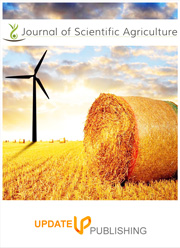Biochar for the Control of Plant Pathogens
DOI:
https://doi.org/10.25081/jsa.2023.v7.8094Keywords:
Biochar, disease resistance, induced systemic resistance, plant growth, pyrolysisAbstract
Biochar, the solid product of pyrolysis of biomass at thermal degradation temperatures, is useful in agriculture as manure for enhancing plant growth through the supply of nutrients. It is used in protected cultivation practices of vegetables and flower crops in the pot culture and grow bags especially to improve soil physicochemical properties, and in hydroponics to remove pollutants like heavy metals in the water. The usage of biochar as a potential soil amendment for plant growth promotion, improving soil fertility and plant disease suppression are being explored in recent years. Biochar made from many of the agro waste materials was found to suppress the plant pathogens in the soil and also effective in controlling the pathogens affecting aerial parts of the plants. Although direct antifungal or antibacterial effects and metabolites of biochar are poorly understood, induced systemic resistance in plants through signal transduction and expression of defence chemicals and metabolites have been studied. In addition, microbiome analyses through metagenome sequencing revealed an increase in the population of beneficial microbes (antagonistic to plant pathogens) in the rhizosphere soils applied with biochar.
Downloads
References
Akhter, A., Hage-Ahmed, K., Soja, G., & Steinkellner, S. (2016). Potential of Fusarium wilt inducing chlamydospores, in vitro behaviour in root exudates and physiology of tomato in biochar and compost amended soil. Plant and Soil, 406, 425-440. https://doi.org/10.1007/s11104-016-2948-4
Choudhary, D. K., Nabi, S. U., Dar, M. S., & Khan, K. A. (2018). Ralstonia solanacearum: A wide spread and global bacterial plant wilt pathogen. International Journal of Pharmacognosy and Phytochemistry, 7(2), 85-90.
Elad, Y., David, D. R., Harel, Y. M., Borenshtein, M., Kalifa, H. B., Silber, A., & Graber, E. R. (2010). Induction of systemic resistance in plants by biochar, a soil-applied carbon sequestering agent. Phytopathology, 100(9), 913-921. https://doi.org/10.1094/phyto-100-9-0913
Hou, J., Pugazhendhi, A., Phuong, T. N., Thanh, N. C., Brindhadevi, K., Velu, G., Chi, N. T. L., & Yuan, D. (2022). Plant resistance to disease: using biochar to inhibit harmful microbes and absorb nutrients. Environmental Research, 214, 113883. https://doi.org/10.1016/j.envres.2022.113883
Jaiswal, A. K., Alkan, N., Elad, Y., Sela, N., Philosoph, A. M., Graber, E. R., & Frenkel, O. (2020). Molecular insights into biochar-mediated plant growth promotion and systemic resistance in tomato against Fusarium crown and root rot disease. Scientific Reports, 10, 13934. https://doi.org/10.1038/s41598-020-70882-6
Jin, X., Bai, Y., Rahman, M. K., Kang, X., Pan, K., Wu, F., Pommier, T., Zhou, X., & Wei, Z. (2022). Biochar stimulates tomato roots to recruit a bacterial assemblage contributing to disease resistance against Fusarium wilt. iMeta, 1(3), e37. https://doi.org/10.1002/imt2.37
Tender, C. D., Vandecasteele, B., Verstraeten, B., Onmeslag, S., Kyndt, T., & Debode, J. (2021). Biochar-enhanced resistance to Botrytis cinerea in strawberry fruits (but not leaves) is associated with changes in the rhizosphere microbiome. Frontiers in Plant Science, 12, 700479. https://doi.org/10.3389/fpls.2021.700479
Yang, Y., Chen, T., Xiao, R., Chen, X., & Zhang, T. (2022). A quantitative evaluation of the biochar’s influence on plant disease suppress: a global meta-analysis. Biochar, 4, 43. https://doi.org/10.1007/s42773-022-00164-z
Published
How to Cite
Issue
Section
Copyright (c) 2023 Sneha Ramesh, Subramanian Babu

This work is licensed under a Creative Commons Attribution-NonCommercial-NoDerivatives 4.0 International License.



 .
.